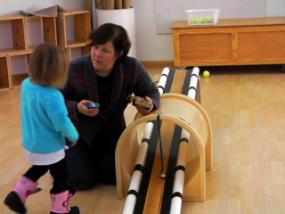Questions to ask young children about causes

A teacher can focus children’s thoughts via her questions, as you will see in this five-minute video. The children are rolling toy cars down a ramp. A bell on a string hangs from a tunnel through which the ramp passes. The larger car reliably makes the bell ring as it rolls through the tunnel. The smaller car often rolls to one side without contact with the suspended bell. In general, the teacher can ask about effects (“What will happen if I use this (larger) car?) or she can ask about causes (“Why does this car work better?”). There are inherent problems with both of these questions.
To the question about effects the child might correctly state, “It will make the bell ring.” But does the child identify the car by its color as the one that made the bell ring a few minutes ago, or does the child understand that it is the width of the car that makes it work? We only know that the child remembers which car works, not why it works.
While the second question seems more answerable than the first, young children find such questions very difficult. They first have to think about some physical dimension and then select the one that is relevant. Not only that, they need to match different values of that dimension to success and failure. And the dimension could be the force they used to push the car as well as differences in the wheels, weight, or size of the car. Which difference makes the difference? And as you will see in this video (00:43) young children often reinterpret a question about causes into a question about effects. They “answer” your why question with a demonstration of the effect. So when the teacher asks the children, “Why does this car work better” the children show her that it works better.
They reenact the effect that the teacher has already mentioned, somewhat because effects are visible and causes are inferences about relevant dimensions, but also because, even if they are thinking about causes, at this age they are more likely to think about their own action as the cause in question, the force of their push, not the width of the car.
The teacher understands the difficulty that children have in thinking of relevant differences between the two cars, to say nothing of then relating those differences to the effect of the ringing bell. She deliberately shifts to what she calls “comparison.” At first the children play this game, but they are not thinking about the dimensions that are relevant to the effect in question. With the teacher's help they identify similarities (four wheels each) and differences (color, weight, and size). During this period a sub-goal develops, and that is learning how to use a strategy that is truly comparative, such as shifting from holding one car at a time to simultaneously holding a car in each hand to compare weights.
We don’t know exactly how the last child in the video figures out why they are playing the “same and different” game, but she does. When the questions turn to size it dawns on her to talk about the bell again (04:19). You cannot hear her exact words, but you do hear the teacher paraphrase them: “This car hits the bell because it’s big. And that one doesn’t because it is too little.” Voila.
While this relation between car size and bell ring might seem obvious, think about the format of the conversation. The teacher encourages the children to move beyond thinking about one car’s success or failure. She shifted the thinking from cars to dimensions (number, weight, and size). She also encourages the children to find the value within a dimension that created the effect while a different value of that same dimension failed (big = yes, little = no). It is this sort of reflection that supports young children's scientific thinking. As John Dewey said many years ago, “It is not experience that is the best teacher, it is reflection on experience that teaches.”
